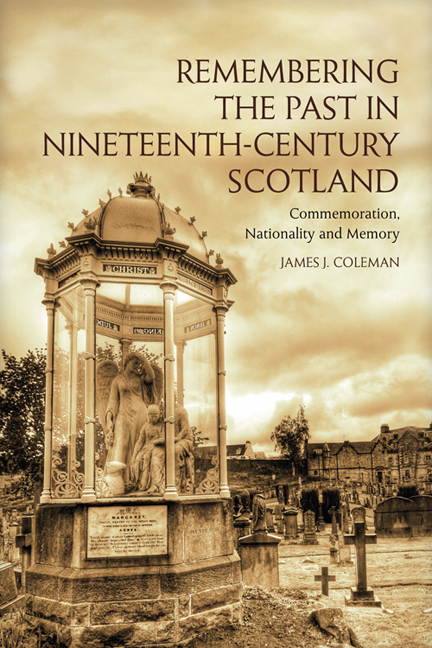Book contents
- Frontmatter
- Contents
- Acknowledgements
- Introduction: The Valley Cemetery
- 1 Nationality, Memory and Commemoration
- 2 Scottish Nationality in the Nineteenth Century
- 3 ‘Not Servile and Conquered, but Free and Independent’: Commemorating William Wallace and Robert the Bruce
- 4 ‘The Highest Position in the Civilised World’: Commemorating John Knox and the Second Reformation
- 5 ‘If They Were Rebels Then, We Are Rebels Now’: Commemorating the Covenanters and the Glorious Revolution
- 6 ‘By the Imprudence of His Ancestors’: Commemorating Jacobitism and Mary Queen of Scots
- 7 ‘Staunch Loyalty to the Flag that Stands for Union’
- Bibliography
- Index
7 - ‘Staunch Loyalty to the Flag that Stands for Union’
Published online by Cambridge University Press: 05 August 2016
- Frontmatter
- Contents
- Acknowledgements
- Introduction: The Valley Cemetery
- 1 Nationality, Memory and Commemoration
- 2 Scottish Nationality in the Nineteenth Century
- 3 ‘Not Servile and Conquered, but Free and Independent’: Commemorating William Wallace and Robert the Bruce
- 4 ‘The Highest Position in the Civilised World’: Commemorating John Knox and the Second Reformation
- 5 ‘If They Were Rebels Then, We Are Rebels Now’: Commemorating the Covenanters and the Glorious Revolution
- 6 ‘By the Imprudence of His Ancestors’: Commemorating Jacobitism and Mary Queen of Scots
- 7 ‘Staunch Loyalty to the Flag that Stands for Union’
- Bibliography
- Index
Summary
THE STRANGE CASE OF THEODORE NAPIER
If the legacy of Mary Queen of Scots was incapable of finding a home within the definition of Scottish nationality, there were some readings of the past that could accommodate her. As noted in the previous chapter, many Scottish Catholics viewed Mary as a Catholic martyr, someone who stood up for the religion of Rome and its Scottish antecedents in the midst of reforming turmoil. Though growing, the Catholic experience was still on the fringes of Scottish nationality, still finding its place in expressing its identity, yet this was not the only national frame within which the Queen could be placed. We encounter a somewhat unusual deployment of Mary in the exploits of the proto-nationalist and ardent neo-Jacobite Theodore Napier when visiting Fotheringay Castle – another focal point for Marian memory – in February 1908. The Times reported:
On Saturday – the 321st anniversary of the execution of Mary Queen of Scots – Mr Theodore Napier journeyed to Fotheringay to place on the castle mound a wreath in memory of the Queen. It was in the form of a large Scottish Stuart crown of everlastings, with the legend in red letters ‘Maria DG Reg Scotorum’, and on a white silk sash attached to it was stated ‘Dedicated to the Immortal Memory of Mary, “Queen of Scots”, Dowager Queen of France, de jure hereditarii Queen of England and Ireland, who, on this spot was beheaded by order of her Royal cousin, Elizabeth on February 8, 1586–87.’ A long quotation from George Mackenzie's ‘Highland Day Dreams’ was also printed upon it, and it was inscribed ‘From Royalists in Scotland, February 8, 1908’. Mr Napier said he was one of the last of the Jacobites, and he could trust no one to bring the wreath but himself, which explained the fact that there was no wreath two years ago, as he was in Tasmania.
Clearly, not everyone preferred to remove any stridently national – or even proto-nationalist – interpretation from the commemoration of Mary or of the Jacobite cause.
- Type
- Chapter
- Information
- Remembering the Past in Nineteenth-Century ScotlandCommemoration, Nationality, and Memory, pp. 176 - 190Publisher: Edinburgh University PressPrint publication year: 2014



